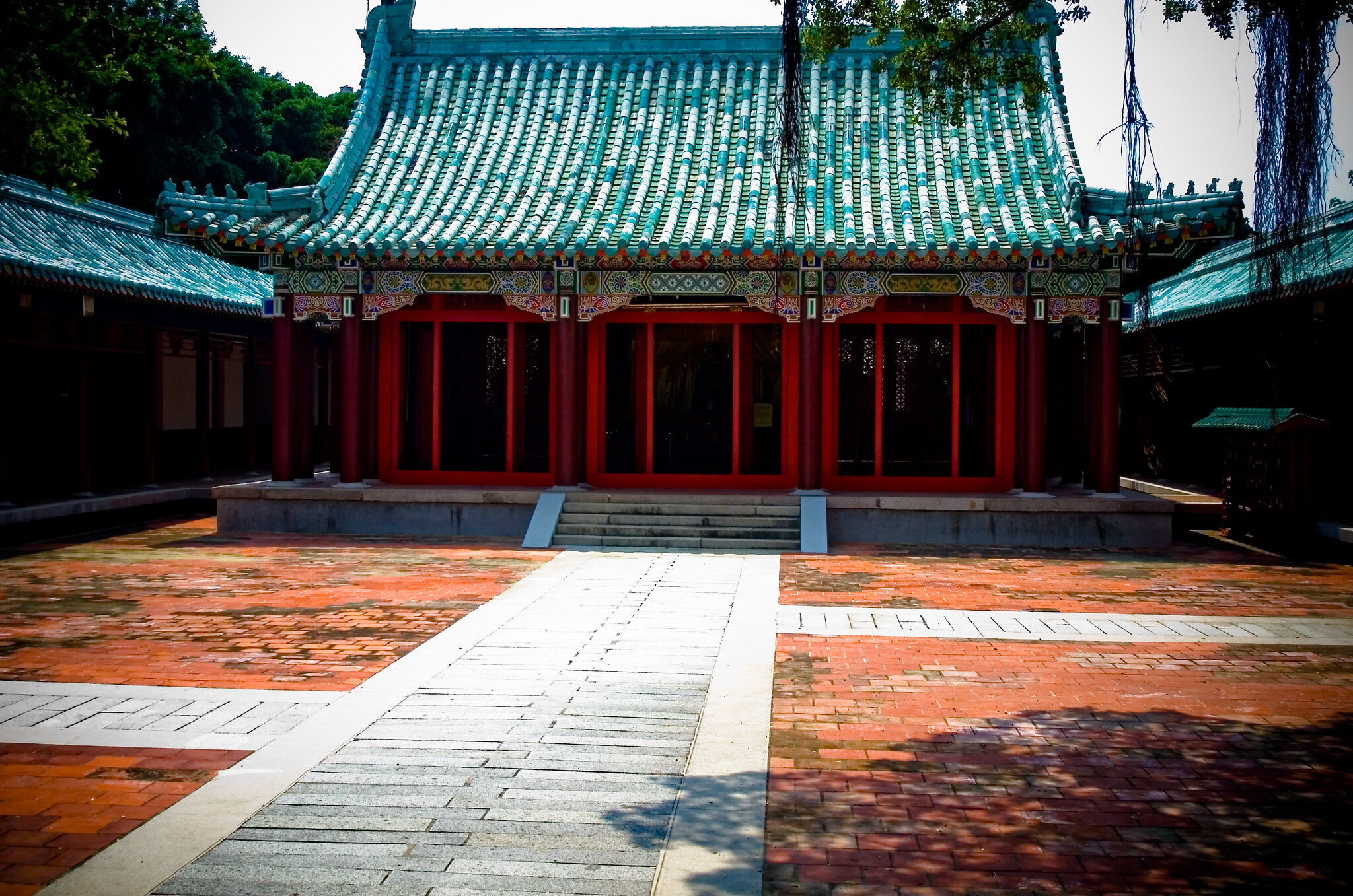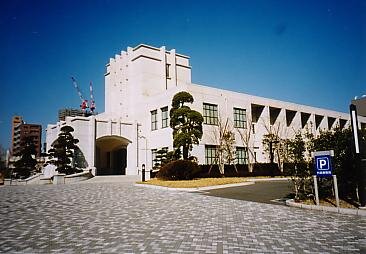Taiwan Jingu
Emergence of Contestation: 1901
Taiwan's general protector shrine, Taiwan Jinja, was established six years after Taiwan came under Japanese control. The three Pioneer Kami were enshrined in the first seat of the shrine, while a second seat enshrined Prince Kitashirakawa-no-miya Yoshihisa, who had died in Tainan in 1895 of malaria, after leading a successful pacification campaign against the remaining Qing loyalists in Taiwan. Like others in Taiwan, the shrine itself was handed over to the Republic of China after 1945, but remained largely unaltered until the 1970s. Then, as part of a broader policy of removing the traces of Japanese colonization and fostering patriotism, the shrine was razed and replaced with the towering Taipei Grand Hotel in 1973, which showcased northern Chinese (as opposed to southern Chinese or Taiwanese) architecture.
Desecration or Veneration: The Legacy of Shinto Shrines at the Borders of Imperial Japan - Karli Shimizu
Puppet Emperor Palace Museum
Emergence of Contestation: 1984
The Puppet Emperor Palace, dedicated to China's emperor Puyi, is at present designed to serve as a "site of memory" for the emperor's life journey from the throne to becoming an ordinary citizen of the newly formed Chinese state, as well as a symbol of China's successfull wartime struggle against the Japanese rule (specifically Japan's puppet government in Manchukuo). However, the site itself did not serve as the stage for most of Puyi's conversion, nor did it figure prominently in the Chinese resistance, which seemingly somewhat undermines its claim to the "site of memory" title. A consideration of the actual history of active Japanese governance associated with the site (as opposed to the "victim narrative" carefully constructed by the CCP) could restore this title to the museum, but would require a departure from the official Party narrative aimed at centering national legitimacy.
Beyond a "Site of Memory": The Puppet Emperor Palace Museum - Emily Matson
Mimizuka (Ear Mound)
Emergence of Contestation: 1597
The Mimizuka memorial can serve as an example of a transformative mnemonic site, where meaning and memory of conflict is continuously reshaped through time. The representations of the monument and the collective memories associated with it shift between communities, generating narratives ranging from reproach to remembrance, and even reconciliation, all the while fueling discussion on how memorialisation is handled in today's society.
Kyoto's Mimizuka: Transformation and Contestation Across Four Centuries - Daniel Milne
Lin Zhao Tomb
Emergence of Contestation: 2013
Lin Zhao (Chinese: 林昭; January 23, 1932 – April 29, 1968), born Peng Lingzhao (彭令昭), was a prominent dissident who was imprisoned and later executed by the People's Republic of China during the Cultural Revolution for her criticism of Mao Zedong's policies. On the date of her death (April 29), memorial gatherings on the site of her tomb was interrupted by the authority with conflicts.
Kuskus Shrine
Emergence of Contestation: 1939
Kuskus Jinja (高士神社), a shrine in the indigenous area of Mudan, practices veneration using Shinto ritual. Built in 1939, indigenous villagers going off to war promised to meet again in spirit at this shrine. The shrine's building was destroyed in 1946 by a typhoon. Although local villagers had long wanted to rebuild the shrine, it wasn't was not until 2015 that the shrine was rebuilt, with financial help from Japanese donors. The newly built Gaoshi shrine venerates the village's war dead, rather than Amaterasu. It is not associated with any Shinto organisations in Japan, but the rites are conducted by a Shinto priest from Japan who is training a local man as his successor. Although the ritual is conducted in a Shinto-style, indigenous and Chinese customs are incorporated into the ceremony,and the shrine is an adaptation of Shinto rites to meet the needs of the community to memorialise their war dead.
Desecration or Veneration: The Legacy of Shinto Shrines at the Borders of Imperial Japan - Karli Shimizu
Kaizan Jingu
Emergence of Contestation: 1896
Kaizan Jinja was established by renaming a seventeenth century site dedicated to the veneration of Koxinga, the Japan-born Ming loyalist and merchant-pirate who drove the Dutch from Taiwan and established his own short-lived kingdom. By request of the new Japanese governor of Tainan, the Taiwan Governor-General swiftly recognised the site as an official Shinto shrine, but retaining the southern Chinese-style buildings. In the late 1930s, a new Japanese-style shrine was built at the site, but the old building was preserved within the shrine garden. The ROC government tore down both the Japanese shrine and the old Chinese building. In its place, a new shrine now part of the Koxinga Museum, was built in a northern Chinese-style of architecture. The koma inu statues and stone torii gate were kept, although the gate's top bar was knocked off and the symbol of the ROC was added to it.
Desecration or Veneration: The Legacy of Shinto Shrines at the Borders of Imperial Japan - Karli Shimizu
June 4th Museum (Tiananmen Incident)
Emergence of Contestation: 2019
The June 4th Museum in Hong Kong commemorates the student democratization movement and the Tiananmen Incident in 1989 in Beijing. There has been several instances that the museum was broken into by the unknown forces and protested against by the pro-Beijing groups in Hong Kong, who claimed that the museum is distorting history. In mainland China the Tiananmen Incident is identified as student riot, which is counter-revolutionary, whereas elsewhere the Incident is widely seen as democratization movement that was repressed by the authorities.
Jiabiangou Labor Camp Sites
Emergence of Contestation: 2013, 2014
Jiabiangou Labor Camp (Chinese: 夹边沟; pinyin: Jiābiāngōu) is a former farm labor camp (laogai) located in Jiuquan in the northwestern desert region of Gansu Province. The camp was in use during the Anti-Rightist Campaign in the years from 1957 to 1961. During its operation, it held approximately 3,000 political prisoners, of whom about 2,500 died at Jiabianguo, mostly of starvation. Remains of the camp, including the graveyards, are unmaintained and heavily guarded to prevent people from visiting. In November 2013, a new monument erected by families and social workers was quickly destroyed by local authorities. Ai Xiaoming, a professor of Sun Yat-sen University, was briefly detained before released and prevented from photographing the site in May 2014.
Okawa Elementary School
Emergence of Contestation: 2011
In the wake of the March 2011 disasters in Tohoku, several remaining ruins have become sites of negative heritage. This site - at which the failure to manage the evacuation of pupils led to tragedy - has been subject of a debate between survivors and the Japanese government, with the former wanting to preserve the school buildings, and the latter seeking to demolish them.
Framing Negative Heritage in Disaster Risk Education: School Memorials After 3.11 - Julia Gerster, Flavia Fulco
Ichigaya Memorial Hall
Emergence of Contestation: 1946, 1990s
The courtroom at the Ichigaya site where the International Military Tribunal for the Far East was held has been preserved through a collaborative effort of conservative and progressive activists. The site was supposedly to commemorate either the Japanese wartime crimes, or the allies' victor's justice over the defeated Japanese leaders. When contrasted with the site of the Nuremberg Trials, however, the site draws little attention to the war trials themselves. Moreover, the items exhibited at Ichigaya make a bias in favour of the "victor's justice" narrative apparent.
Competing Memories of Victor's Justice vs Aggressive Warfare at Ichigaya Memorial - André Hertrich
Ainu Remains
Emergence of Contestation: 1869
The Ainu human remains stolen from Hokkaido gravesites for scientific purposes in the period of the Japanese colonisation of Hokkaido are presently still housed in museum collections across the globe, provoking protest from Ainu activists who demand their return. The remains themselves have become sites of memory through which Japanese colonial amnesia is challenged.
Stolen Ainu Remains as Sites of Memory - Michael Roellinghoff
Meiji Shrine
Emergence of Contestation: 1912
The Meiji Shrine today is a popular tourist destination, and a site for a wide variety of events and festivities. However, the Shrine also functions as a mnemonic site with various audiences, and is attached with a complex web of meanings, - at times seemingly contradictory, - from the veneration of the Meiji emperor to a symbol of postwar democratisation. The Shrine is a centre not only for religious life, but also for historical consciousness.
Forgetting War and Remembering Progress at the Meiji Shrine - Peter Zarrow
Tsugaru Storytelling
The "Wa no mukashi-ko" storytellers from the Tsugaru region in Aomori construct heritage through inherited oral folklore recited in dialect, which they adapt and pass on to the local people. This vernacular tradition stands in contrast with the hegemonic discourse of authenticity linked to the region through narratives manufactured in the country's centre in Tokyo.
The Inheritance of Voice, Intentionality, and Provincial Japan: Storytelling in Tsugaru - Joshua Lee Solomon
Kyoto War Heritage
Emergence of Contestation: 1945
Members of the 16th Division of the Imperial Japanese Army stationed in Kyoto were sent out across the Asia-Pacific, linking various sites across the city to Japan's military past. This past and the associated sites, however, are conspicuously absent from Kyoto's tourism landscape, and remain a negative heritage, yet to be dealt with.
Kyoto's Contested Asia-Pacific War Heritage: Sites of the Army's 16th Division - Justin Aukema
Christian Sites of Nagasaki
Emergence of Contestation: 1600s, 2018
The Nagasaki region features a number of historic sites of hidden Christian worship. The sites serve both the goals of institutional tourism as internationally recognised Japanese heritage, and the narratives of local guides as sites of importance to rural folk culture. Neither narrative can be considered the dominant one.
World Heritage, Tourism, and Cultural Intimacy in Nagasaki - Raluca Mateoc
Hokkaido Jingu
Emergence of Contestation: 1869, 1895, 1945, 1949-1987
The Shinto shrines built over time along the expanding Imperial Japanese border carried different associations in different locations across varying points in time. While the shrines in Hokkaido retained a religious association even after the war and were linked to the pioneer narrative, in colonial Taiwan the shrines were primarily locations of patriotic worship of the dead, and, as they became set as secular after the war, they transformed into symbols of a multicultural Taiwan.
Desecration or Veneration: The Legacy of Shinto Shrines at the Borders of Imperial Japan - Karli Shimizu
Arahama Elementary School
Emergence of Contestation: 2011
In the wake of the March 2011 disasters in Tohoku, several remaining ruins have become sites of negative heritage. This site - an example of a successful evacuation - is being preserved as a monument to the importance of disaster preparation (BOSAI).
Framing Negative Heritage in Disaster Risk Education: School Memorials After 3.11 - Julia Gerster, Flavia Fulco
































